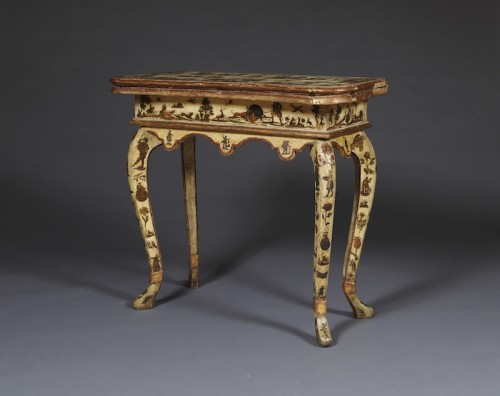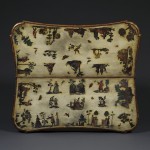9605 A CHARMING PAIR OF CREAM LACCA POVERA FOLDING TEA TABLES German or Possibly Swedish. Second Quarter 18th Century. Measurements: Width: 30 1/2″ (90cm) Depth:15 3/4″ (40cm) Height: 27 1/2″ (70cm).

Research
Of pine with white lacquer and mounted with decoupage chinoiserie figures and scenes on every surface. Faced on four sides, top with hinges, opening to reveal a top with similar decoration, back legs extend to support the top when open. Lambrequin-shaped apron on four sides with four outward-facing cabriole legs with high knees. Some old repairs to mechanism that had been glued shut, but now functions having been unglued. Repairs to some apron sections and some engravings replaced where lacking.
Provenance:
An Old Private Collection, Uppsala, Sweden.
Lacca povera, sometimes also known as lacca contrafatta, was something of a craze among fashionable circles in the early eighteenth century. In 1727 Mademoiselle Charlotte Aïssé wrote “we are here at the height of a new passion for cutting up colored engravings … Everyone great and small, is snipping away. These cuttings are pasted on sheets of cardboard and then varnished. They are made into wall panels, screens and fire boards. There are books and engravings costing up to 200 livres; women are mad enough to cut up engravings worth 100 livres apiece. If this fashion continues they will be cutting up Raphaels”.1 This quote proves that the embellishment of furniture by amateurs, by hand using cut-out engravings, was far from a cheap option, indeed calling the technique “poor lacquer” is very misleading, as the materials were expensive and the technique meticulous and complex.
Another letter from M. Constatin of 1727 confirms this trend: “tapestry and knotting are no longer in question; one has left behind spinning wheels and shuttles; one wants nothing but decoupage. All kinds of furnishings suitable to this technique are being decorated; screens, folding screens, wall hangings, ceilings, the tops of coaches and sedan chairs; it is being put everywhere.”2 Corroborating the suggestion that aristocratic and royal ladies learned the lacca povera technique is a firescreen at the Charlottenburg Palace in Berlin which bears the initials of the Queen of Prussia, Sophia Dorothea, herself.3
This new creative endeavor was encouraged by a number of publications on the subject, that gave instructions on how to mix the required varnishes – although many of these had titles such as The Ladies Amusement; or, Whole Art of Japanning made Easy, often what was being described was in reality decoupage or lacca povera, of the kind seen on the present tables. On the present examples however this is unlikely the work of an amateur; the process has clearly been adopted and improved by a professional furniture maker.
The present pair of tables perfectly exemplifies the range of different kinds of subject that were selected to decorate lacca povera pieces. On the legs are single figures and flowers, on the frieze are hunting scenes and exotic birds, and on the closed tops are figures engaged in various activities and interaction. Flower vases have been cleverly selected to highlight the corners of the outside and inside of the tops. On the inside top, the surface used for gaming, a theme appears to be figures in pairs engaged in some form of joint activity, perhaps referencing the tables’ intended use.
In Germany and Italy, much more experimentation in color and material is discernable when it comes to the taste for lacquer, as well as in decorative choices when compared to Britain and France; the taste for white lacquer was partially owing to Europe-wide craze for oriental porcelain. White lacquers appear to have obtained a special popularity in Germany and collectors such as Duke Anton Ulrich of Brunswick (1633-1714) were obsessive about collecting it.
The white finish of the present tables was achieved using a carefully formulated recipe, frequently the craftsman would need to wait weeks before the lacquer had dried enough for it to undergo sanding, polishing or the addition of any decoupage decoration. A publication of 1732 gives a recipe for a usual white lacquer; 48 loths of the best rectified spiritus vini which ignites the gun powder, 5 loths of the purest sandarac pulverized and simmered in a clean cloth, 5 loths of fine, cleared and prepared Venetian turpentine, 6 loths of pure mastic grains. The maker would then place the ingredients in a clean glass vial and shake as much as possible for a good hour, set it in a Bain Marie on a straw wreath and let it simmer in this water for five or six hours so that the species dissolves in the spiritus vini. Once this has occurred, open the glass again, and pour the varnish through a clean bag or cloth into a clean dish or glass.4 Many recipes also recommend filtering the varnish well and allowing it to stand to allow larger fragments to fall to the bottom in order to aid the transparency of the lacquer.
The main centers of production in southern Germany were Augsburg and Nuremburg, which were already leading European artistic centers in a number of other fields. Many of the German tracts on the production of lacquer were produced in Nuremburg; publishers of prints in both these cities published general Chinoiserie design source books that could be used as inspiration for lacquerers, as well as images intended to be used as ‘cut-outs’ in the lacca povera technique, as seen on the present pieces. The most famous German lacquerer was Gérard Dagly who was based in Berlin; a pair of extraordinary white lacquer cabinets at Boughton House in Northamptonshire have been attributed to him.5
These beautifully drawn but unusual tables came from an old Swedish collection, and it is not out of the question that they were made there. Certainly the art of lacca povera decoration was immensely popular in nearby Denmark; both wives of Frederick IV of Denmark were noted enthusiasts of the former practice, as was the king’s brother Prince Charles.6 Scandinavian countries also had direct access to German productions, especially via the Baltic port of Hamburg. Lacquer became especially sought after in Sweden owing to the activities of the Swedish East India Company, which although not as famous or successful at its Dutch or British counterparts, had a very significant impact on taste and fashion in Sweden, as did the publication of the influential architect William Chambers (1723-1796), (who was of Swedish and Scottish heritage), Designs of Chinese buildings, furniture, dresses, machines, and utensils : to which is annexed a description of their temples, houses, garden. The Swedish were also especially keyed into developments of fashion in France, owing to the activities of the architect, designer and diplomat Carl Gustav Tessin (1695-1770), who was at the heart of the French court and sent back regular updates on what was occurring. Carl Fredrik Adelcrantz (1716-1796) would design the Chinese pavilion at the Swedish Royal park of Drottningholm in 1750, marking the high point of the taste in Sweden.
The basic but effective mechanism is of a cleverly contrived character, whereby two of the legs extend out from the frieze by means of two inset supports on which the folded top rests. Such tables are often referred to as Klapptische in German inventories of the period. Other examples of the same system can be found in major collections of furniture in Germany, such as one in the Ansbach Reisdenz, which has a chequered games board on the exterior surface for chess, and an interior surface of velvet for card games.
Footnotes:
- Lettres de Mademoiselle Aïssé a Madame Calandrini, Paris, 1943 p. 97, quoted in Daniëlle O. Kisluk-Grosheide, “’Cutting up Berchems, Watteaus, and Audrans’: A Lacca Povera Secretary at the Metropolitan Museum of Art”, Metropolitan Museum of Art Journal, v. 31, 1996, p. 81
- The letter was published in the Mercure de France of Dec. 1727, pp. 2889-2894, quoted in Kisluk-Grosheide, op. cit.
- Hans Huth, Lacquer of the West : the history of a craft and an industry, 1550-1950, Chicago 1971, p. 72
- Katerina Walch, Johan Koller, Baroque and Rococo Lacquers, 1997, p. 27
- Tessa Murdoch, Boughton House: The English Versailles, London 1992, p. 80
- Huth, op. cit., p. 105






Comments are closed.